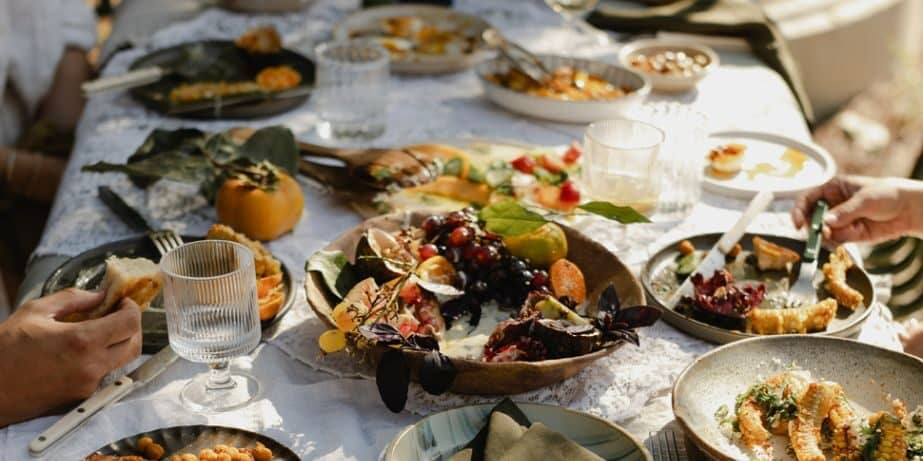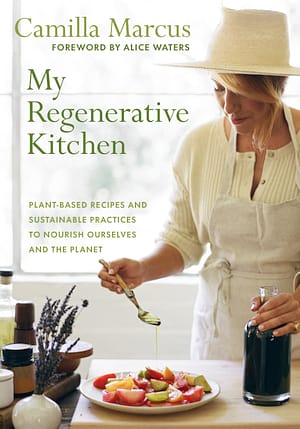Sweet Brunch Delights: Doughnut Holes, Breakfast Cake & Fruit with Tahini Yogurt

Looking to elevate your breakfast or brunch recipes? Treat yourself to this delightful trio that promises to satisfy your sweet tooth and will have your guests asking for seconds!
Through elegantly simple recipes and thoughtful techniques, Camilla Marcus—chef, restaurateur, and founder of the sustainable products brand west~bourne—encourages readers to embrace a whole-farm mentality and adopt a zero-waste approach in the kitchen.
Each recipe is filled with professional tips drawn from Camilla’s extensive restaurant career, along with inspiration for a laid-back, inspired lifestyle. My Regenerative Kitchen will guide you to take risks, cook with intention, and help regenerate our Earth through the way you live, cook, eat, and gather every day.
The following recipes are from My Regenerative Kitchen by Camilla Marcus. It has been adapted for the web.
(Photography credit: Ben Rosser)
Welcome to a Work in Progress
Cooking is about letting go and living with abandon. Finding your way with what’s grown and releasing the instinct to exert control. It’s the very feeling I imagine musicians vibe on when playing jazz, not knowing where the notes and rhythm will lead or end up, which is entirely the point of the experience. To be present, savoring the winding road of the process.
While improvisational cooking might feel daunting at first, as is so often the case when we depart from routine, give yourself some grace and surrender to experimenting. With time and some trial and error, hopefully you too will find that sweet spot where you can find joy in adapting alongside nature as she wants and discover that not being in control can be both liberating and inspiring.
In this book, as with the ethos of my recipes and culinary style, I chose film photography to capture everything just as it is, raw and unedited reality in all its messiness—just like Mother Nature. We wanted to honor the slowness of an intentional process, as I believe consistency and immediacy are overrated.
Through stories, photography, research, recipes, techniques, and pro tips, this book seeks to be an inspiring guide for your personal journey to radically let go and regenerate our Earth through how you live, cook, eat, and gather every day.
Brioche Doughnut Holes
Makes about 15
The legend of Stan’s Donuts in Los Angeles will far outlive the restaurant’s life, which sadly ended in recent years. Stan’s was in the heart of Westwood and kept prices at 1950s levels despite massive growth in popularity. The air hung with warm, yeasty notes in the tiny shop, still a core memory I can conjure from regular family excursions.
A note on flour: There are so many sources for regenerative, climate-centered flours. From King Arthur to Central Milling to Local Millers, there are plenty of mindful options that I encourage you to try and hopefully integrate as your pantry staples.
- 8 cups (1.1 kg) all-purpose flour, plus more for dusting
- 1 cup (160 g) light coconut sugar
- 2 tablespoons (30 g) kosher salt
- 1 1/2 tablespoon (13 g) active dry yeast
- 1 cup (240 ml) milk
- 4 large eggs
- 1/2 cup (120 ml) avocado oil
Topping Mix
- 1 cup (130 g) light coconut sugar
- 2 teaspoons ground cardamom
- 1 teaspoon ground cinnamon
- 1/4 teaspoon sea salt
For Frying
- 3 to 4 cups (710 to 945 ml) avocado oil
To Serve (optional)
- Preserves, crème fraîche, and/or honey
To make the dough, combine the flour, sugar, kosher salt, and yeast in a stand mixer fitted with the dough hook. Add the milk and eggs and mix on medium speed for 10 to 12 minutes, scraping down the sides with a spatula as needed. Halfway through, add the avocado oil in a steady stream and continue mixing until the dough is well combined and starts to pull away from the sides of the bowl, about 5 minutes. Transfer the dough to an airtight container and let the dough ferment in the refrigerator for 24 hours.
The next day, transfer the dough to a clean work surface and cut the dough in half. Put one half back into the container and refrigerate to use at a later time (or freeze it for up to 1 month for future use; thaw on the counter overnight before using).
Roll the dough into a log 11/2 to 2 inches (3 to 4 cm) thick, adding flour to the work surface as needed so the dough doesn’t stick. Cut 1-inch (2.5 cm) portions using a small knife or bench scraper. The pieces should look like large gnocchi, plump and slightly squared with four corners. Transfer the dough pieces to a baking sheet until ready to fry.
To make the topping mix, in a large bowl, whisk together the sugar, cardamom, cinnamon, and sea salt.
When you’re ready to fry, pour the oil into a large, wide pot and heat over medium-high heat until the oil reaches 350°F (180°C). Gently place up to 5 dough balls into the hot oil one at a time, give them a minute or so, then flip. When cooked and golden brown on all sides, use a slotted spoon to transfer them directly to the bowl of topping mix. Toss to coat, then serve hot or at room temperature as is or with the garnish of your choice.
Breakfast Cake with Preserve Swirl
Makes one 6-inch (15 cm) cake
We experimented for a long time as a team at west~bourne to craft a unique gluten-free muffin recipe. The original intention was to use cover crops that are essential to a regenerative farm ecosystem but are underutilized and often misunderstood, like buckwheat. With that North Star, we also challenged ourselves to create an all-natural gluten-free mix, free of chemicals and additive binders that often besiege these kinds of products. With that, it could be nourishing to the Earth and highly nutritious for us, even as a sweet finish to a meal.
- Avocado oil, for greasing
- 1 cup (170 g) organic light coconut sugar
- 1/2 cup (80 g) gluten-free oat flour
- 1/2 cup (80 g) gluten-free light buckwheat flour
- 1/2 cup (80 g) gluten-free sorghum flour
- 2 1/2 tablespoons psyllium husk powder
- 1 1/2 tablespoons baking powder
- 1 teaspoon sea salt
- 2 teaspoons golden flax meal
- 2 teaspoons milled white chia seeds
- 1 1/2 cups (355 ml) milk or unsweetened nondairy milk of choice
- 1/4 cup fruit preserves of choice
- Crème fraîche, whipped cream, or ice cream, for serving (optional)
Directions
Preheat the oven to 350°F (180°C). Line a 6-inch (15 cm) cake pan with parchment paper, lightly oil, and set aside.
Sift together the coconut sugar, oat flour, buckwheat flour, sorghum flour, psyllium husk powder, baking powder, salt, flax meal, and chia seeds. Gently whisk in the milk until combined and smooth, being careful not to overmix.
Pour the batter into the prepared pan and lightly tap the pan on the counter to settle the batter. Spoon the preserves onto the center of the batter and swirl it around using a fork for dispersion and design. Bake for 40 minutes, until a knife inserted in the center comes out clean. If it’s not fully cooked, the cake will collapse out of the oven, so be sure not to take it out before it’s ready.
Remove from the oven and place on a wire rack to cool a bit. Serve warm with a dollop of crème fraîche, fresh whipped cream, or a scoop of ice cream. Or, just eat it straight out of the pan.
PRO TIPS: Transform this into a simple squash cake by replacing the preserves with 1/2 cup (127 g) pureed cooked squash or pumpkin, folded completely into the batter before cooking.
Fresh Fruit Bounty with Tahini Yogurt and Furikake Hazelnut Brittle
Makes 4 servings
The idea here is a Renaissance of fruit, not your average fruit plate. I encourage you to incorporate fruits you maybe have never worked with before, embracing the bounty our farmers work so hard to harvest. When we shot the photos for this book, I was inspired to try something new myself. I had kiwano melon for the first time in Paris when I dined at Table by Bruno Verjus.
The first course is a thrilling exploration of fruit and vegetables locally and seasonally grown both raw and cooked and vibrant as an artist’s palette. When you trim the spiky orange rind of the melon, the inner flesh and seeds are tart, bright, and subtly vegetal, adding an intriguing complexity. Sweet, savory, generous, and decadent, this dish is ideal at brunch or for a large-format table dessert.
Th
Ingredients
- 1 cup (240 ml) plain, unsweetened yogurt
- 1 tablespoon tahini
- 2 teaspoons honey
- Maldon salt
- 2 tablespoons finely chopped Furikake Hazelnut Brittle (or you can use any sort of seed-and-nut crunch you like)
- 4 to 6 whole fresh fruit of choice (see headnote)
- 2 tablespoons extra-virgin avocado oil
- 2 tablespoons fresh herb leaves (see headnote)
Directions
In a small bowl, mix together the yogurt, tahini, honey, and a pinch of salt and set aside in the refrigerator. Put the brittle in a bowl in the freezer until ready to use. If you don’t have brittle, you can use any sort of seed-and-nut crunch you like, something that adds great texture.
Prepare the fruit next, removing pits and cores as needed and slicing into large rustic pieces or even halves, depending on the size.
To plate, choose a large serving bowl or platter and spread the tahini yogurt over the bottom. Place the fruit on top of the yogurt, then garnish with the chopped brittle, a sprinkle of salt, a drizzle of avocado oil, and the herbs.
Recommended Reads
The Hunt for Wild Huckleberries and Buckwheat Huckleberry Buckle Cake
Seasonal Desserts: Apple Spice Bundt Cake & Pumpkin Pie with Hazelnut Crust
Recent Articles
What’s so great about oyster mushrooms? First, you can add them to the list of foods that can be grown indoors! They are tasty, easy to grow, multiply fast, and they love a variety of substrates, making oyster mushrooms the premium choice. The following is an excerpt from Fresh Food from Small Spaces by R. J.…
Read MoreCraving something sweet? These delicious maple roasted nuts are the perfect treat to help you push through those end-of-winter blues. The following is an excerpt from Full Moon Feast by Jessica Prentice. It has been adapted for the web. The Magic of Maple: A Rich History Following the Hunger Moon, just before the first thaw…
Read MoreDoes the cold weather have you dreaming about fresh greens and colorful salad? Grow and harvest sprouts indoors to make those dreams a reality! Follow this quick start guide to year-round greens for fresh salad greens in just a couple of weeks! The following is an excerpt from Year-Round Indoor Salad Gardening by Peter Burke. It…
Read MoreMove aside, maple! We have two new syrups to add to the table. Read on for insights on tapping, selling, and eating syrup from walnut & birch trees.
Read More










